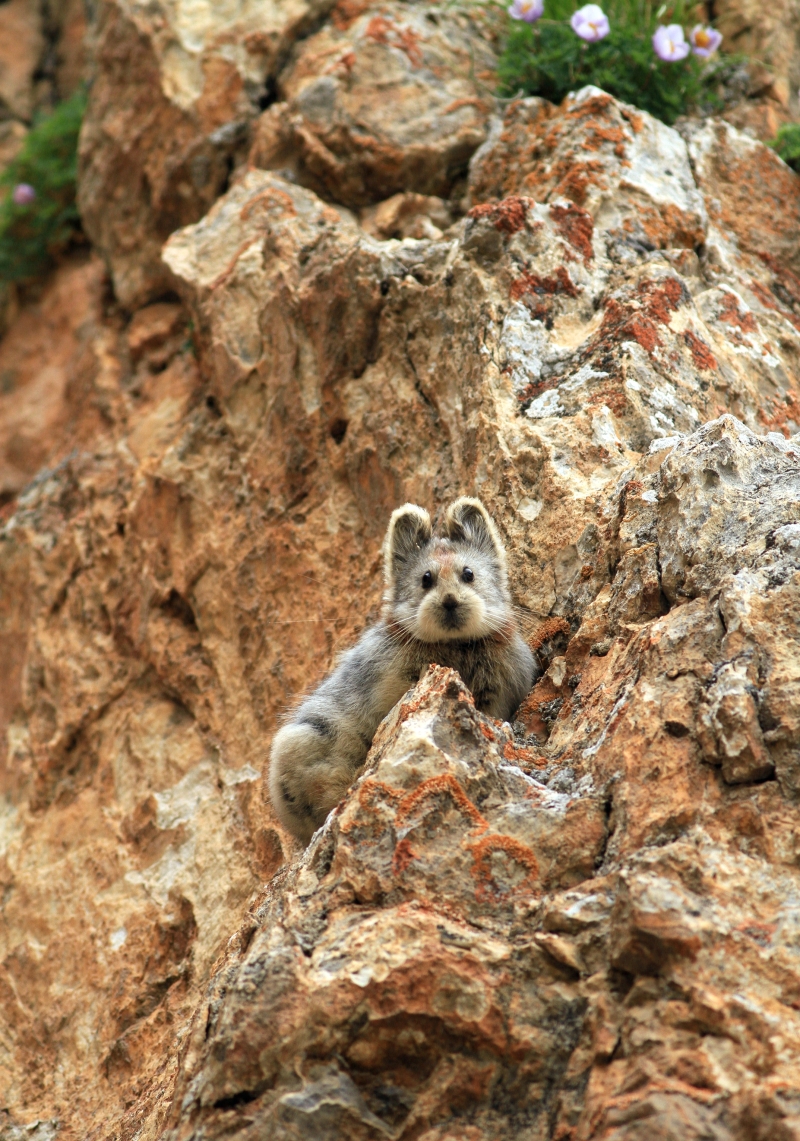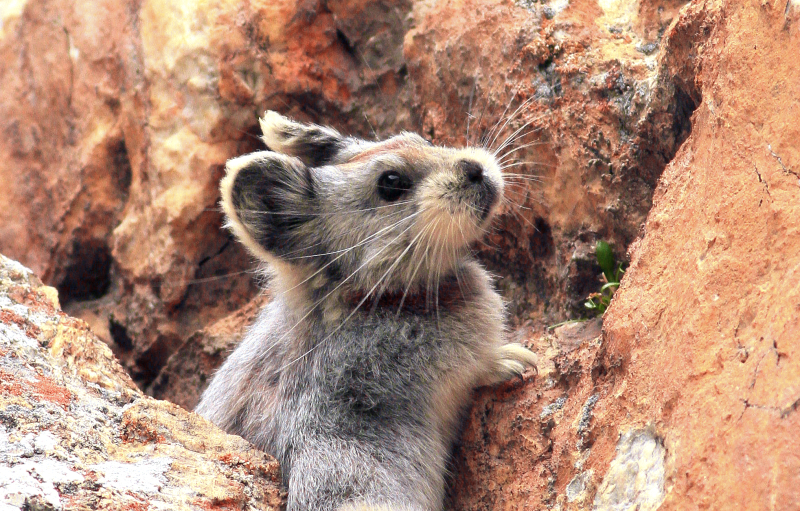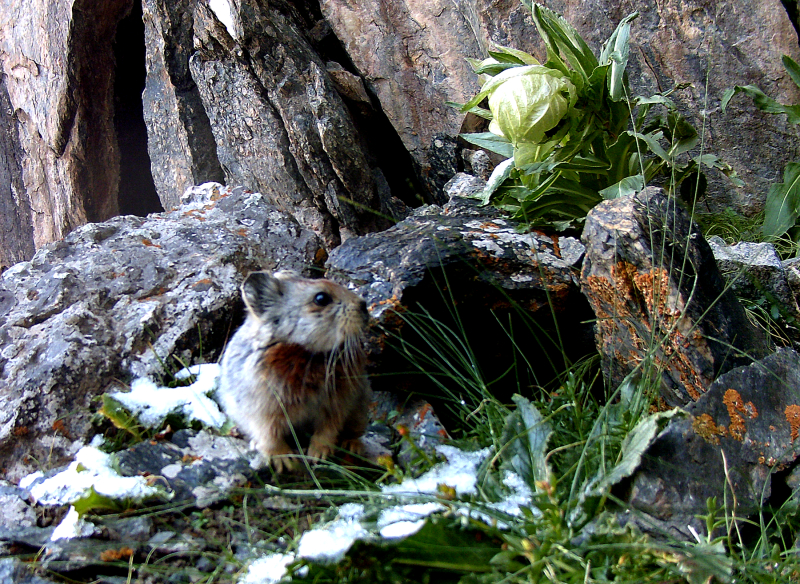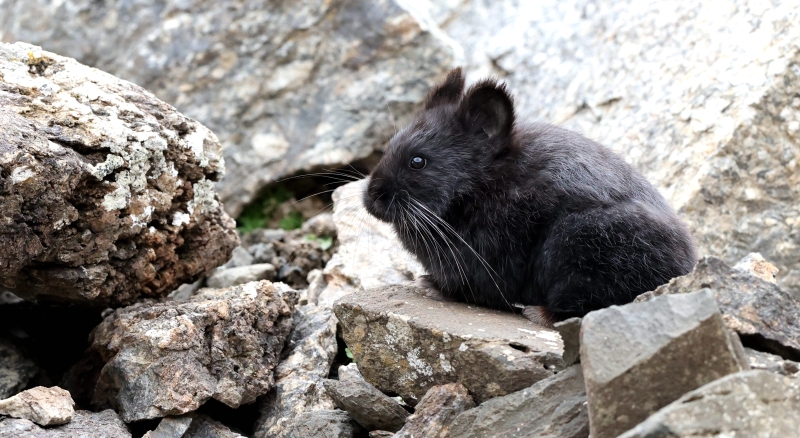Shiliuyun - Xinjiang Daily (Reporter Zhao Mei) news: 40 years ago, Li Weidong accidentally spotted a small animal -- Ili pika in the rocks of the Tianshan Mountains, which changed his life, and contributed to the shift of his occupation from a medical worker to a wildlife conservator.

Photo shows Li Weigdong, who has been searching Ili pikas in the rocks of the Tianshan Mountains for 40 years. (Photo offered by Li Weidong)
Since then, he started searching Ili pikas in the rocks of the Tianshan Mountains, learning their stories, and calling on more people to protect the animal.

Photo taken on July 9, 2014 shows an Ili pika spotted by Li Weidong when he was setting infrared cameras in the Tianshan Mountains. (Photo offered by Li Weidong)
Now, under the conservation and promotion of Li Weidong and his volunteer team, Ili pika is listed as the Second-class State Key Protected Wildlife of China, and sanctuaries have been set up in their habitats No.1 Glacier and Jinghe County. Ili pika, once was unknown to the world becomes very popular on the internet.
A small animal looks like a cross of a mouse and a rabbit
Although Ili pikas are under protection, Li Weidong still has worry about them, “It is a cold-tolerant animal, and with global warming, shrinking range and numerous natural enemies, it could become extinct without manual intervention.

Photo shows an Ili pika in the rocks of the Tianshan Mountains. (Photo offered by Li Weidong)
At present, Li and his volunteer team still promote the conservation of Ili pikas, “I wish we could build a national park or a nature reserve in the No.1 Glacier, and then build an Ili pika conservation and breeding base in the nature reserve, to propagate their population through artificial breeding.”
Li Weidong, 67 years old now, with gray hair, is much less sturdy and agile than he was in 40 years ago, though, he still works in bare rocks of the Tianshan Mountains and keeps a close eye on Ili pikas.
“Every time he goes into the wilderness, he drives hundreds of kilometers, taking rough mountain roads, and comes to mountain feet covered with gravels. Then he climbs to mountain tops over 4,000 meters with bare hands, and sets up infrared cameras, checks faeces, urine and stored straws of Ili pikas. Only by doing so, would he set his mind at ease,” said Tian Xiangdong, a volunteer who participated in investigations in the wild with Li before.
Before encountering Ili pikas, Li Weidong was a medical worker in the medical system of Ili Kazak Autonomous Prefecture. “We had found rampant poaching for wildlife such as red deer when we were working outside, and we had been shocked a lot by living conditions of some endangered wild animals.”
In July, 1983, when Li and his team were investigating in the mountain area in Nilka County, Ili Kazak Autonomous Prefecture, Xinjiang, they spotted a small animal that they had never seen before in the back hill of a herdsman’s household. “The animal looked like a cross of a mouse and a rabbit with taupe furs and three rusty brown spots on its head and neck.” When he asked about it from local herdsmen, no one gave an answer. The animal had never been recorded on any documents in the world.
Therefore, he started searching the animal among cliffs of main peaks of the Tianshan Mountains. On August 14, 1985, on his 30th birthday, he finally gathered two samples, so as to identify the little thing. “With the classification and identification of experts, it is a new species that is totally different from more than 20 species of pikas that exist in the world. After I got the result, I was very excited.”
In 1986, since Li was born and raised in Ili, he decided to name the animal Ili pika, and finally made it get recorded.
“Barometer” of climate change
However, the discovering of the new species was just a beginning.
“What about the distribution of their population? What about their habits? What they feed on? What about their activities? How they propagate? Whether they hibernate or not? All of these questions were waiting for us to figure out,” said Li Weidong. So, he and the team kept working in the rocks of the Tianshan Mountains.

Photo shows Ili pika, an ancient residual species. (Photo offered by Li Wiedong)
They found that Ili pika is an ancient residual species, which can be dated back to the Late Miocene. At present, they have only been found distributing in the Tianshan Mountains in China’s Xinjiang, inhabiting in bare rocks of 2,800 to 4,100 meters above the sea level. Ili pika is also a special species of Tianshan alpine ecological system, who is very sensitive to climate change and is regarded as the “barometer” of climate change.
Although Ili pikas look like mouse, they belong to Lagomorpha. They don’t drink water, only eat rare medical vegetation such as snow lotus, arctic root and dragonhead, so their faeces can be made into medicine, which is called “Cao Ling Zhi” (herbal effective lipid) in The Compendium of Materia Medica (Bencao Gangmu, literally “categories and principles of roots and herbs”) for treating convulsion of children.
They have a special way of life. Everyone of them lives a solitary life, and during their courtship and territory making, they would rather send messages by their faeces and urine like carnivores than chirping like other pikas.
During their investigation, Li and his team found that Ili pikas are endangered, their population is small, and the habitat is highly fragmented. “Any subtle effect could make them disappear in many areas.”
Therefore, Li has played the issue down in the 2 decades since he discovered Ili pika. “At first, I didn’t want them be bothered, and I was afraid that poaching could happen if they attract too much attention.” From 1992 to 2002, he even took the measures of “no promoting, no interference and no sanctuary".
Even so, they found Ili pikas’ population dropped rapidly.
“In the 22 years from 1992 to 2014, their population shrunk by two-thirds, which numbers fewer than 1,000.” Li said that among the 14 observation points located in the Tianshan Mountains, Ili pikas could only be observed in 2 of these observation points of Jinghe County and the No.1 Glacier. “ Except for Nilka County where I discovered Ili pika for the first time, I didn’t spot a single of them since 2006. Every time we do investigations, there are only some faeces weathered for a long time. By analyzing reasons, in addition to the shrinking area of glaciers in the Tianshan Mountains caused by global warming, there are also some human interference such as adventure travel and herdsmen grazing.” Since then, he managed to change his protecting measures -- investigating comprehensively the 14 observation spots and appealing to more people to protect Ili pikas.
Explore a new protecting way from ordinary people
Li Weidong said, during the years he didn’t spot Ili pikas, he was stressed out. “ I can’t accept them going extinct since they are discovered and named by me.”

Photo shows Li Weidong and his team. (Photo offered by Li Weidong)
On July 9, 2014, when Li was setting infrared cameras in Tianshan regions, he finally spotted another Ili pika. It was the first time in 22 years he saw Ili pika again, which made him very excited, then he immediately snapped its photos.
He is worried that after this encounter, another long waiting could happen again, so he established a workshop on natural ecological protection and built a volunteer team to make every effort to promote the conservation of Ili pikas.
Soon after, Xinjiang Uygur Autonomous Region approved the establishment of Tianshan No.1 Glacier conservation area, and Jinghe County established Ili pika sanctuary. At the same time, plants and mines around No. 1 Glacier were permanently shut down, and grazing and tourism were forbidden, so that the populations of wildlife such as snow leopards have increased effectively.
With improving environment of the sanctuary, Ili pikas have been frequently caught by infrared cameras. “Some of these images provide important evidence for our scientific research. For example, images show, in addition to medical vegetation, Aconitum kusnezoffii Reichb, a kind of toxic herb is on their menu, and they are nocturnal, and have many natural enemies.” Li said that 8 years ago, black pika was caught by infrared camera, which was lately identified as the variant of Ili pika through research.

Photo shows a black pika, which was lately identified as the variant of Ili pika through research. (Photo offered by Li Weidong)
In 2022, Li and his team explored a new way driving people to participate in the conservation of Ili pika. “We cooperate with local enterprises, develop Ili pika cultural and creative products on the basis of Ili pika IP, images, the workshop LOGO, etc. Enterprises promise that they would donate one yuan as long as one product can be sold out. Such cooperation mode not only promotes the local economic construction and development, but also supports a part of expenditure of the sanctuary.” Now,the team is full of experienced volunteers, running conservation works orderly.

Photo shows Li Weidong and representatives of a company who signed contract with Li’s workshop. (Photo offered by Li Weidong)
(A written permission shall be obtained for reprinting, excerpting, copying and mirroring of the contents published on this website. Unauthorized aforementioned act shall be deemed an infringement, of which the actor shall be held accountable under the law.)









